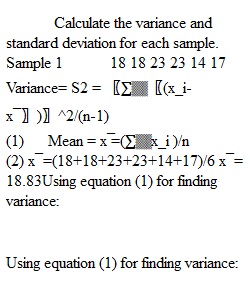


Q 1. : For the following data on the sentence length of drug possession (measured in months), 1) Calculate the variance and standard deviation for each sample. (20%) 2) What do the different standard deviations between the two samples indicate? (5%) Solution: 1) Calculate the variance and standard deviation for each sample. (2) The standard deviation measures the variability in our data collection on average. It informs us how far each score deviates from the mean on average. A high standard deviation implies that values are typically distant from the mean, whereas a low standard deviation suggests that values are grouped near to the mean. 2. : A police department’s administration is interested in understanding the citizens in her city. The department randomly surveys 20 citizens and asks them to rate how satisfied they are on a scale of 1-9, where 1 is extremely dissatisfied 9 is extremely satisfied. Here is a simple frequency table of the collected data: 1) Calculate the range. (5%) 2) Calculate the variance. (10%) 3) Calculate the standard deviation. (5%) 4) Which of them is the least accurate measure of variability? (5%)
View Related Questions